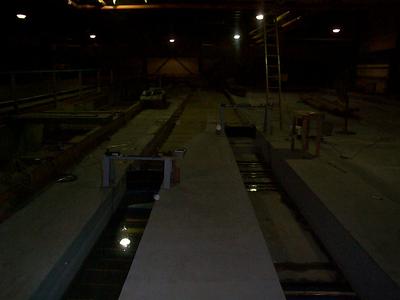8 August, 2001
Greetings from Hanover, New Hampshire,
The orientation for the members traveling to the Arctic or Antarctic for
the 2002/2003 research season began on Monday and has been an
incredibly informative experience. I had many questions and concerns
regarding this program. What will be required of me? Where will I be
going? What research project will I be working on? The numerous
presentations thus far have really opened my eyes, and I am very
excited about the program that I am now a part of. Several researchers
have presented information regarding their individual projects, and
past parcticipants have shared their experiences. There is so much
exciting research being conducted both in Antarctica and the arctic.
Today we, the new members of the TEA program were given a tour of CRREL
(Cold Regions Research and Engineering Laboratory) which is located
here in Hanover, and has been the site of the orientation this week.
CRREL is a U.S. Army Corps of Engineers facility whose function is
research and engineering focused on cold areas. The site is quite large,
covering around 30 acres, and consists of many independent buildings.
The tour covered several of the buildings. The Ice Engineering Facility
contained several large tanks used to model real situations. As we
entered the building the smell of ammonia lingered in the air. Len
Zabilanski, a research civil engineer leading our tour of this
building, informed us that the ammonia smell was from the cooling system
used for the research. He said with a grin, "If the cold doesn't get
you, the ammonia will." One recent project involved modifying a lock to
better allow the movement of ship traffic during times of ice build-up.
During times of heavy ice flow, when the locks are opened ice will move
in ahead of the ship or barge and slow or prevent the movement of the
vessel. The model that was tested involved forcing air bubbles into the
water from beneath as the vessel entered the lock. This forced the ice
out of the lock, and allowed the ship to move in and out relatively
unimpeded. The ice was then allowed to move down an alternate lock to
help keep the channel free for future ships.
A second building that was toured was the Frost Effects Research
Facility. The building was very large, open on both ends and reminded
me of a large bus garage. As we entered the building, two men on their
knees were scraping a bed of crushed rock with trowels and placing
white sensors in the ground. The main function of this facility was to
conduct research on the ground surface and below. A recent project that
was conducted here involved looking at alternate subsurface materials
for roads. Cycles of freezing and thawing can cause frost heaving that
cracks and structurally weakens road surfaces. The traditional crushed
rock subsurface has the potential to hold large quantities of water,
thus increasing the effects of the heaving. The experiments that were
tested involved laying down man-made materials (similar to carpets)
between the subsurface and the asphalt. Sensors were put in place
beneath the fabric and asphalt to measure stresses.
A heavy vehicle simulator, a very large machine that can apply forces
similar to automobile traffic was used to roll tires across the areas
being tested. This machine can model many years of vehicle traffic over
a much shorter time. While the vehicle traffic is being simulated the
roadbed is put through cycles of freezing and thawing, and the sensors
are used to measure stresses. The results of experiments like these may
one day help to develop paving systems that last longer, require less
maintenance and are therefore cheaper in the long run.
I was very impressed with the entire tour. It is exciting to clearly see
the application of science to real situations. As I observed the many
different facilities of the CRREL one question continued to surface for
me; can I as a teacher help make science as meaningful and practical to
my students as what I observed during this tour?
Life Is Good!

Ice engineering Facility at CRREL. Model of a lock system to allow for = better vessel movement during times of high ice flow.

The Heavy Vehicle Simulator located in the Frost Effects Research = Facility. This enormous machine can model many years of heavy road = traffic over a short period of time.
Contact the TEA in the field at
.
If you cannot connect through your browser, copy the
TEA's e-mail address in the "To:" line of
your favorite e-mail package.
|
